
Callister Brewing: the Community of One
In an issue of a magazine dedicated to the topic of Community, and featuring a battery of public-minded businesses who manage to stand out in an industry replete with community-oriented owners, there should be no simple way to single out one brewery as the focus of a lead story. But there is. In fact, it was one of the easiest tasks in compiling this periodical. Because in all of British Columbia, there is only one craft beer business which encompasses a commercial brewing community within its walls.
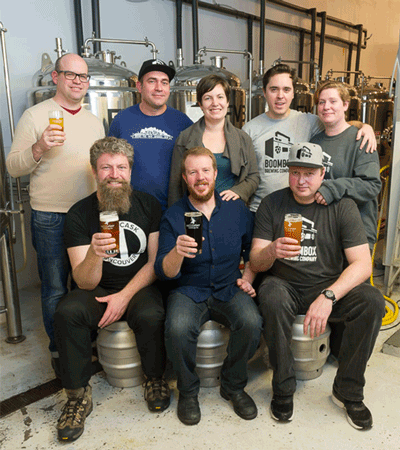
Billed as “Canada’s First Collaborative Brewery”, Callister Brewing Company made its much-anticipated debut in 2015 after a building phase during which beer-loving pedestrians on East Vancouver’s Franklin Street were teased with the promise brewing within a strikingly-coloured red building.
Many brewery businesses are born as the result of two people with a shared passion answering a sometimes-gruelling calling. At its core, that happens to be the case with Callister, but those two people—life partners Diana McKenzie and Chris Lay—navigated a different path towards brewery ownership than their craft community peers. They saw an opportunity to do something different, something that nobody had tried in a brewery, possibly anywhere in North America. The closest thing may have been a short-lived “co-working brewery” in Houston TX, sunk by brewers playing a game of nude Twister. The more serious approach developed for Callister would showcase a group of “associate brewers” sharing a brewhouse, taproom and resources in a combined effort to create a sustainable operation containing multiple brewing partners.
Ink has been spilled about this by many a beer writer, so the introduction ends there. Now, 20 months after its genesis, Callister continues its experimental journey, bravely pioneering an approach that almost certainly will be studied closely by others far or near considering how to mitigate the risk of entering an industry that can demand fairly massive startup investment. Here’s what I learned from the people involved in the venture’s second year.The Vanbrewers connection
As Nathaniel Senff of Lightheart Brewing says, one can’t really discuss Callister and community without talking about the Vancouver Homebrewers Association. Although it’s not officially accurate to say that Callister’s commune-like workgroup is a direct spinoff of Vanbrewers, it’s not far from the truth. It’s where the brewers involved met and built the trust necessary to take the leap into a much more meaningful working relationship than simply sharing homebrew recipies.
Not that they’ve left Vanbrewers behind. Matter of fact, right up until this past AGM in February 2017, leaders of the various Callister co-brewers were doing double duty with key positions within Vanbrewers. Nathaniel has long served as an administrative and IT coordinator for the club, while former CAMRA Vancouver president Adam Chatburn, now known as Real Cask Brewing, was Membership Director and Meeting Director. Kent Courtice of Boombox Brewing was also handling Events in the past. Working within the brewing community context is not new to these people.
For the aforementioned fellows, joining a brew club provided not only a network, but inspiration to brew more and better. Kent recalls the epiphany he experienced when a friend brought him to his first Vanbrewers meeting in the back warehouse at Parallel 49. Nathaniel was sharing his smoked Baltic Porter. Kent was blown away; he remembers thinking that it was as good as any pro beer he had sampled. He had gone in thinking “my beers are this good” (gesturing with hands fairly wide apart). After participating for a while, he knew he had to up his game, and judging by popular and critical response to Boombox, that’s exactly what has happened.
The VB connection continues out of both friendship and practicality. Both Adam and Nathaniel, who are more or less solo, have had various Vanbrewers (and other local brew club members) come in, help out and get commercial brewing experience.

Learning the ropes
Of course, they’re still getting commercial brewing experience themselves. Nathaniel, who watched from the sidelines then jumped in for Year Two, says “I thought I had the advantage of knowing what to expect. But brewing on that scale…it kicks your butt. Your first couple of brew days, you’ll be feeling like you ran a marathon”. Leaning on his Armed Forces leadership experience, he says that “sometimes you just have to suck it up”.
The guys agree that there’s always something that comes up when you are brewing, and it rarely goes completely smoothly. Kent confides, “To find the process that fits what we brew, it took us the first seven months.” Considering that the stated timeline extended right up to about a week before this interview was held, you get the idea that despite Boombox’s acclaim (snagging a couple of trophies at the 2016 BC Beer Awards) these people are not taking anything for granted.
Building their own brands
The opportunity presented by Chris and Diana has enabled the three Co-Brewer groups to turn pro with far less risk than would otherwise be possible. But has it helped establish them as brands that are recognized on their own?
Nathaniel says that they’re starting to get people coming in who ask for their specific brands. “I had people come in and ask ‘Where’s the Citranaut?’“, he relates. “When you run out of beer, that’s when you find out that people appreciated it.”
The Co-Brewers sign on for a year at a time, starting July 1. Diana and Chris are open to the idea of managing Callister to some extent as a brewery incubator, annually providing a potential launchpad for participants. No doubt, those who do really well here will eventually need to leave to grow. Of Boombox, Kent says, “We are looking for our own space. With all the new breweries popping up, finding our own place has been the biggest challenge.”
Can these brands endure after leaving the Callister nest? So far, the only example to study is Year One’s Machine Ales, who left to brew out of South Vancouver’s Dogwood Brewing.
Rebranded as Superflux Brewing, they are well respected but are essentially a part-time enterprise. Time will tell whether Callister gives birth to a series of successful progeny.
Not everyone needs to leave to consider the experiment a success. For his part, Adam says “I could never have a brewery on my own. My focus [English Ales, including milds] is too niche.”

Like a craft beer food fair
Which brings up one of the great benefits of visiting Callister. The four distinct parties creating beers have different brewing styles. Like sours? Maybe you’re a hophead? Just want something sessionable? With twelve taps (three each from four different brewing teams), chances are that there’ll be something for you, and since this is currently a non-packaging brewery, the lineup is always changing.
Adam, whose focus most clearly lends itself to sessionability, says that “Not having core brands makes it different and kind of exciting. Sure, I try to keep the Bitter coming back fairly consistently, but month to month you’ll get a different slate.”
Nathaniel notes that this is “a big thing about the Callister community experience.” Their size makes it possible to have no core brands, increasing the ability to experiment. He estimates that maybe a third of returning drinkers want the same beers they know.

The owners’ perspective
As do most couples who mix home and business life, Diana McKenzie and Chris Lay play different and complementary roles when at work. Chris handles the beer side, while Diana runs the business. Of course there’s overlap, as Lundy Dale uncovers in her Women In Beer spotlight on Diana in this issue.
They pursued the Co-op concept both out of desire and necessity. “Wanting to work with other brewers in this concept was our idea from the beginning”, Diana notes. “Delays to get permits and licensing are very long, so that eats in to your budget very fast” she adds, confirming that startup costs were definitely eased due to the model of having Associate Brewers buy in up front. Chris notes a side benefit of the business model: from a marketing perspective, the brewery stands out more in a crowded scene than it would have otherwise.
As with the other brewers, he was amazed by what he found at Vanbrewers, seeing it as an “untapped resource” with a huge number of highly talented hobbyists. “They need access to the world, and vice versa, the world needs access to them”. This influenced their decision to create a “community of brewing—not just a brewery, but a community”.
Of course, they could simply have set up a brewery, aligned themselves with a club like Vanbrewers and had a rotation of amateur brewers cycle through as interns. They realized early on that they wanted involvement to be a professional commitment. “We wanted it to be an actual pursuit, and not just an extension of their homebrewing”, Diana asserts.
Asked what they’ve learned from the first year that they can apply to their current second season, Chris talks about learning how to share space. “You have to have respect for each other” he says. Part of that is keeping the space ready for others, because it affects their work. “At other breweries, you might be able to get away with cleaning up later (ie, tomorrow). but here you have to clean up right away so the space is ready for someone else”.
Regarding the previous point about variety in styles between brewers, Chris notes that he has “not yet brewed an IPA, because the other brewers are already doing an excellent job at that”. He feels his style is ” more European or experimental beers”, and likes the freedom to brew what he wants. As long as there are other individuals who can see the benefits of Callister’s model, he’ll be brewing to suit his whims for some time to come.
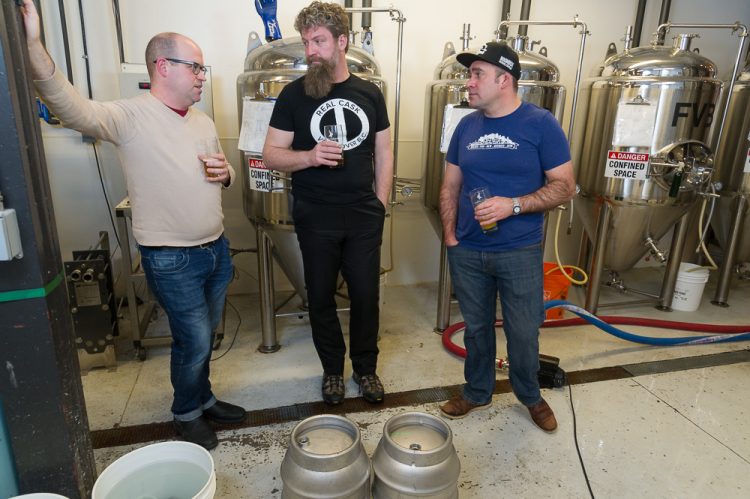
Callister Crew Q & A
What’s Brewing asked Callister team members what they thought about the following topics.
Callister is a unique operation. Do people understand the concept? How much explaining goes on each week?
Diana McKenzie: Yes. We get new people in all the time, but it only takes a few moments to explain the board menu and that everything is made on-site.
Adam Chatburn: I’m always happy to explain our unique nature, I can usually explain it in 2 sentences but could go longer. People are fascinated by the story of the little brewery that got by with a little help from its friends.
Is it a marketing benefit to have multiple brands under one umbrella? Do people even realize in advance that this is available?
AC: People don’t often know about us before they come in and we do’t have much of a marketing budget but if one of the breweries gets some buzz then it benefits us all.
Chris Lay: I felt we really needed to stand out [in a crowded brewery market]. Honestly, who cares about just us [Chris & Diana] opening a brewery?
DM: We get people coming in only for cask ales and we have others who come in only for the IPAs so we can reach a wider audience with the variety we offer. People love that there’s always something new.
How do the four constituents work together to keep things harmonious, efficient and interesting?
DM: The brewing space and equipment is booked by each brewer as they need it. Ingredients are each brewer’s responsibility but we share shipments and try to coordinate orders as much as possible.
AC: We regularly share some ingredients and equipment, but like good room-mates we ensure that we ask and return anything we use. Brewing space is set up on a Google calendar so we can book our day in advance. Most of us brew on a regular day of the week so clashes haven’t happened.
I love taking shifts at the tasting room, people are always surprised to meet a brewer pouring drinks and have the opportunity to ask difficult questions that might stump the tasting room staff. It’s also great to get your feedback directly from the customers- more brewers should consider doing this every now and again.






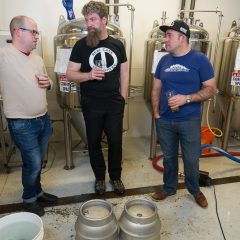


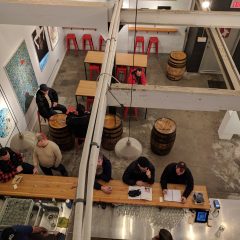

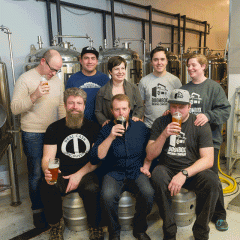


This Post Has 0 Comments